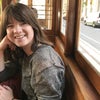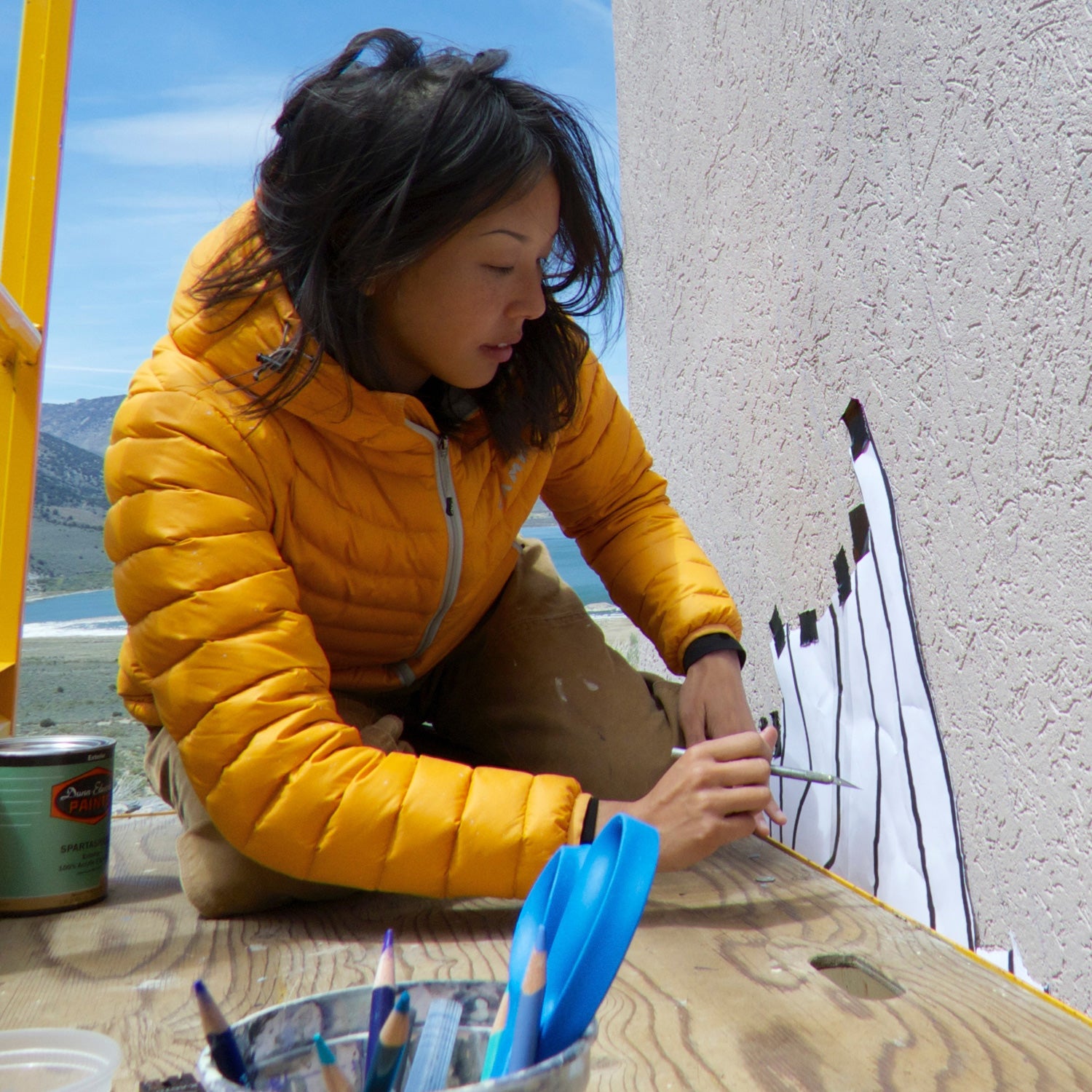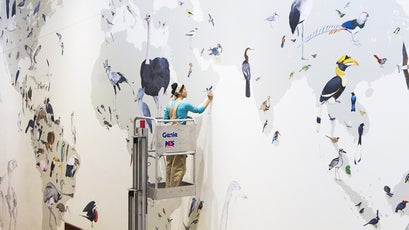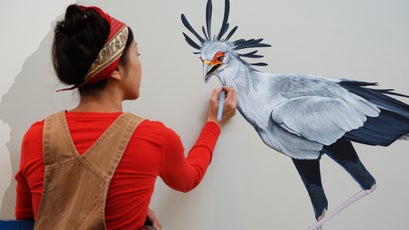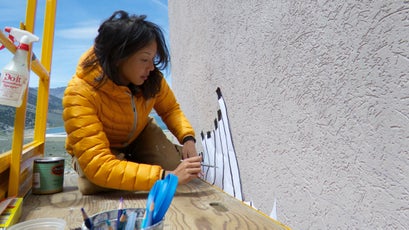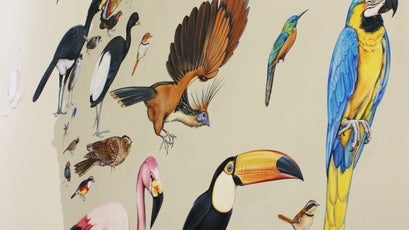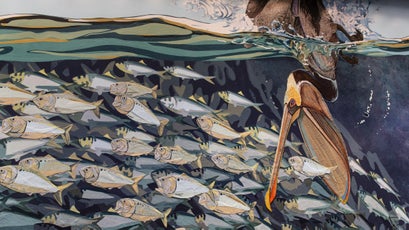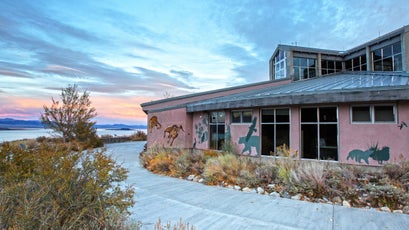Jane Kim was nearing the end of a science illustration internship at the ┬áin 2011ÔÇöhoning her ornithology drawing skillsÔÇöwhen John Fitzpatrick, the labÔÇÖs director, showed her a blank┬á3,000-square-foot, four-story-high wall in the labÔÇÖs visitor center. ÔÇťThat wall has been screaming to be a mural since we moved inÔÇŁ eight years earlier, Fitzpatrick told Kim. He wanted to commission a mural that depicted a bird from every modern living family, plus many of the species from which theyÔÇÖd evolvedÔÇö270┬áspecies in total.┬á
Cornell Ornithology has a long history of working with distinguished natural history artists, and Fitzpatrick had floated the idea by some. But all had balked at the scope of the project. Kim did the math in her head and said yes almost immediately. 
Two and a half years after starting the project, in December 2015,┬áKim capped off the labÔÇÖs centennial year by ┬áthat stands as one of the largest and most ambitious ever created. It showcases on a map of the world a species from every modern bird family,┬áincluding 12 new families that were discovered while Kim worked on it. Each creature is painted to scale, from a five-inch marvelous spatuletail hummingbird to a 30-foot Yutyrannus. And each is crafted┬áwith exacting scientific accuracy that would be challenging in a sketchbook.
Kim spent much of her time on a scaffolding setup, built so she could work on upper reaches of the wall. She often preferred to work through the night, when there were no distractions. ÔÇťSheÔÇÖs been like Michelangelo, way up on that lift day after day,ÔÇŁ Fitzpatrick says.┬áÔÇťThis has never been done before. I daresay this may never be done again.ÔÇŁ
As a scientific illustrator, Kim, 34, is part of a niche set of artists who are bringing the centuries-old craft into the 21st century. For the most part, science illustration means drawing flora and fauna so accurately that the depictions can be used for reference. Charles Darwin did it, as did John James Audubon. Kim has taken this to the next level by moving the art out of sketchbooks and textbooks and onto massive exhibition-scale walls. 
For an exhibit that opened at the National Aquarium in May, Kim created┬áwall-spanning paper mosaics of┬áthree distinct coastal ecosystems. For an ongoing┬áKickstarter-funded┬áproject called┬á┬áthat Kim started in 2011,┬áKim paints migratory animals, like bighorn sheep,┬áon buildings that look out onto┬átheir natural habitats. Each becomes part of a┬áseries of murals, set over hundreds of miles,┬áthat actually follows the speciesÔÇÖ migratory path. The idea of the Migrating Mural, which pretty neatly describes Kim's overall mission,┬áis to take science illustration out of museums and┬áeven closer to its original subjects.
Kim hopes that her approach brings new relevance to the┬áeducational art that inspired her, but is also┬áwidely considered┬áantiquated today.┬áAround┬áthe 1920s, visitors flocked to see taxidermied┬áanimals set before┬álifelike dioramas┬áof their native habitat and fellow┬áwildlife. ┬áIt's thanks to these striking displays that the┬áHall of African Mammals┬ábecame an archetypal image of the museum experience. But educational┬áinstitutions┬áare increasingly hesitant to dedicate permanent space to something as old-school as a diorama.┬áNewsweekÔÇÖs Max Kutner explained the ÔÇťÔÇŁ in an article published in August: ÔÇťSome have supercharged their century-old displays with gaudy interactive and multimedia features. Others have left them alone and allowed them to fall into disrepair. The worst offenders have scrapped the old dioramas, pillaging them for parts and banishing their remains to storage or garbage dumps.ÔÇŁ
ÔÇťWhen I see people marveling at the mural like itÔÇÖs a scientific illustration, asking questions, that for me is the best thing ever,ÔÇŁ Jane Kim says.
The Wall of Birds, as Cornell dubbed the project, will remain a permanent fixture in the labÔÇÖs visitor center, which Fitzpatrick acknowledges is a rarity as museums plan to tear down displays and opt for┬áshowier and temporary┬áprojects.┬áBut itÔÇÖs also a reminder that art remains one of the most visceral and beautiful ways to learn about science. ÔÇťWe wanted this to be a bold and permanent statement,ÔÇŁ Fitzpatrick says. ÔÇťThatÔÇÖs what the lab is. ItÔÇÖs a bold experiment and weÔÇÖre in for the long haul.ÔÇŁ┬á
The lab is currently stitching together about 400 high-resolution photos of the Wall of Birds so that anybody can explore it online in great detail. But Kim says the best way to experience it is in person.┬áÔÇťWhen I see people marveling at the mural like itÔÇÖs a scientific illustration, asking questions, that for me is the best thing ever,ÔÇŁ she says. When people take in the entire wall from afar, Kim hopes they see a bigger picture of birdsÔÇÖ stunning diversity, the remarkable work of evolution. The lab named the mural ÔÇťFrom So Simple a Beginning,ÔÇŁ pulled from a sentence in Charles DarwinÔÇÖs On the Origin of Species thatÔÇÖs also a fitting parallel to KimÔÇÖs transformation of that huge, white wall. ÔÇť…Whilst this planet has gone cycling on according to the fixed law of gravity, from so simple a beginning endless forms most beautiful and most wonderful have been, and are being, evolved.”

